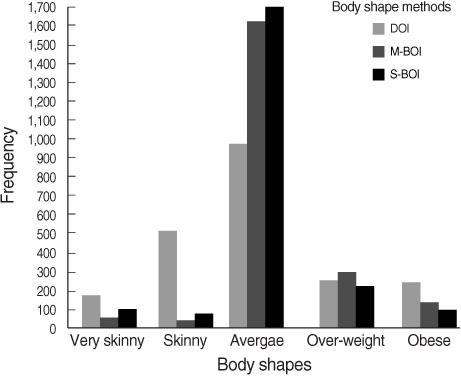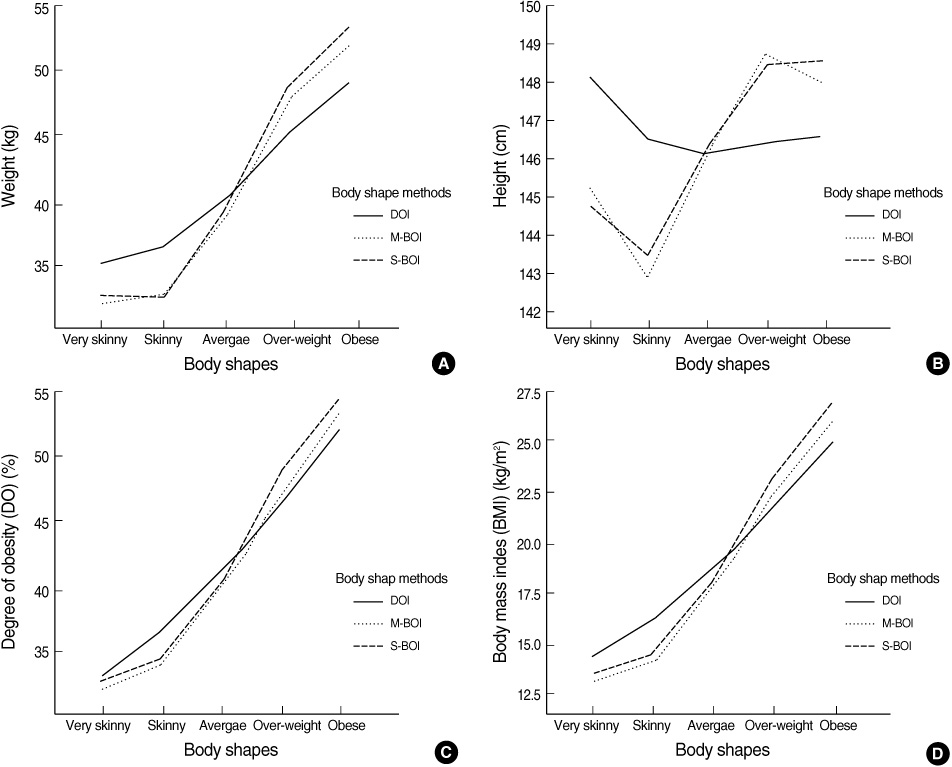J Korean Acad Nurs.
2010 Dec;40(6):775-784. 10.4040/jkan.2010.40.6.775.
Comparison in Weight, Height, Degree of Obesity and Body Mass Index Among Different Methods for Body Shape Classification in School-Age Children
- Affiliations
-
- 1Department of Nursing, Inha University, Incheon, Korea.
- 2Department of Nursing, Gangneung-Wonju National University, Wonju, Korea. choish@gwnu.ac.kr
- KMID: 999480
- DOI: http://doi.org/10.4040/jkan.2010.40.6.775
Abstract
- PURPOSE
The study was conducted to describe body shapes of school age children using the degree of obesity index (DOI) and body mass index obesity index classified by the Ministry of Education, Science and Technology (M-BOI) and Seoul Metropolitan Office of Education (S-BOI).
METHODS
In this cross sectional descriptive study health screening data for school children collected in 2007 was used.
RESULTS
Data were analyzed for 2,193 4th-6th grade boys (52%) and girls who attended 4 schools in rural areas. DOI determined that only 44.3% of students had average weight. This proportion was much lower than the results of other methods (74.3-77.6%). All three methods defined girls (51.3-61.8%) as skinnier than boys. Skinny and average body shaped children classified by DOI and obese children classified by S-BOI were heavier and taller and presented higher degrees of obesity (DO) and BMI scores than by other methods. M-BOI and S-BOI presented statistically significant positive correlations with weight, height, DO and BMI, while DOI was not correlated with height.
CONCLUSION
BMI based body shape classifications provide a more rigorous classification of body shape which are favorable for school health professionals with limited resources and policy makers for internationally comparable references.
MeSH Terms
Figure
Cited by 1 articles
-
Associations among the Degree of Nonalcoholic Fatty Liver Disease, Metabolic Syndrome, Degree of Obesity in Children, and Parental Obesity
Min-Su Oh, Sorina Kim, Joon-Hyuck Jang, Jong Yoon Park, Hyun-Sik Kang, Mu Sook Lee, Ki Soo Kang
Pediatr Gastroenterol Hepatol Nutr. 2016;19(3):199-206. doi: 10.5223/pghn.2016.19.3.199.
Reference
-
1. Butte NF, Garza C, de Onis M. Evaluation of the feasibility of international growth standards for school-agedchildren and adolescents. The Journal of Nutrition. 2007. 137:153–157.2. Choi SH, Ahn YM, Lee SM. Classification of body shapes using obesity indexes in children. Journal of the Korean Society of Living Environmental System. 2009. 16:639–647.3. Joo EJ, Kim IS, Kim YS, Seo EA. Determining the frequency of obesity and eating habits of older (4th, 5th, 6th grade) elementary school students in Iksan city by some obesity indices. Korean Journal of Community Nutrition. 2001. 6:16–27.4. Jung IK. A study on body image perception and weight control by degree of obesity in male students. Journal of the Research Institute of Korean Education. 2006. 24:21–39.5. Kim HY, Kang BH. Assessment of nutritional status. 2009. 3rd ed. Seoul: ShinKwang.6. Kim JH, Lim IS. Correlation of measurements for body fat in obese children. Korean Journal of Pediatrics. 2004. 47:485–490.7. Kim SJ, Kim SY. Correlation between percentage of body fat by BIA and other obesity indices. Korean Journal of Pediatrics. 2004. 47:491–495.8. 2005 Health behavior and chronic disease statistics. Korea Centers for Disease Control and Prevention. 2006. Retrieved May 28, 2010. from http://www.cdc.go.kr/kcdchome/FileDownload.do?file=/board/171/2008082118593585_20916_0.pdf.9. Online health behavior survey in youth, 4th(2008). Korea Centers for Disease Control and Prevention. 2009. Retrieved May 28, 2010. from http://healthy1318.cdc.go.kr.10. Lee KH, Hwang KJ, Huh ES. A study on body image recognition, food habits, food behaviors and nutrient intake according to the obesity index of elementary children in changwon. Korean Journal of Community Nutrition. 2001. 6:577–591.11. The white paper on children and youth. Ministry for Health, Welfare and Family Affairs. 2008. Retrieved May 28, 2010. from http://stat.mw.go.kr/homepage/data/year_data_content.jsp?menu_id=22&curr_page=1&ctrl_command=doNothing&seq_no=10322.12. Data collection manual for health in school age children. Ministry of Education, Science and Technology. 2009. Retrieved May 28, 2010. from http://www.mest.go.kr/me_kor/inform/info_data/welfare/__icsFiles/afieldfile/2009/04/27/p.hwp.13. School health inspection rules. Ministry of Government Legislation. 2009. Retrieved May 28, 2010. from http://law.go.kr/LSW/lsInfoP.do?lsiSeq=93670#0000.14. Moon JS, Lee SY, Nam CM, Choi JM, Choe BK, Seo JW, et al. 2007 Korean national growth charts: review of developmental process and an outlook. Korean Journal of Pediatrics. 2008. 51:1–25.15. Park YS, Lee DH, Choi JM, Kang YJ, Kim CH. Trend of obesity in school age children in Seoul over the past 23 years. Korean Journal of Pediatrics. 2004. 47:247–257.16. Seo JS, Lee JH, Yoon JS, Cho SH, Choi YS. Nutritional Assessment. 2008. Seoul: Power book.17. 2010 Student health evaluation. Seoul Metropolitan Office of Education. 2010. Retrieved May 28, 2010. from http://www.sen.go.kr/web/services/bbs/bbsView.action?bbsBean.bbsCd=94&bbs-Bean.bbsSeq=3144.18. Yang KH, Kim YH. The factors related to obesity level of upper level elementary students. Journal of Korean Society for Health Education and Promotion. 2004. 21:133–146.19. Yu KH. A study on the dietary behaviors, physical development and nutrient intakes in preschool children. The Korean Journal of Nutrition. 2009. 42:23–37.
- Full Text Links
- Actions
-
Cited
- CITED
-
- Close
- Share
- Similar articles
-
- A Study on the Body Fatness and Lifestyles of Some Medical Students
- Body mass index and body composition scaling to height in children and adolescent
- The Percentiles of Body Mass Index and Trend of Obesity in Schoolage Children in Seoul
- Difference of the Obesity Index, Blood Pressure and Serum Lipids in Abdominal and Non Abdominal in Men and Women
- The Physical Development and Dietary Intake for Korean Children and Adolescents Body Composition and Obesity Prevalence



